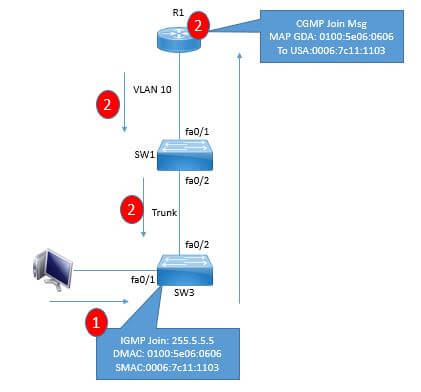EMAIL SUPPORT
dclessons@dclessons.comLOCATION
USLayer 2 Multicast Technique
In LAN there are three methods for LAN multicast optimization.
- CGMP: Cisco Group Multicast management protocol
- IGMP Snooping
- RGMP: Router-port group management Protocol
Let’s discuss these topics and its working
CGMP:
Cisco Group management protocol has following features:
- It is cisco propriety protocol
- It is used because switch does not understand IGMP message.
- Switch by default floods multicast traffic to all switch ports in broadcast domain. CGMP helps layer-2 switch to determine how to distribute multicast traffic to host and switch does not understand multicast address.
- CGMP enable router to communicate to switch switch port about layer-2 multicast MAC address through CGMP message and CGMP modify the CAM table for switch
- Only Router generates the CGMP message, switch only listen to CGMP message and to achieve this, CGMP must be enabled on both router and switch connection.
- Layer 3 switch acts as router for CGMP and on these switches CGMP can be enabled on layer 3 interface that connect to layer-2 switches.
Int fa0/0
No switch port
Ip cgmp
- Destination Address of CGMP is well known CGMP multicast address 0x100:0cdd: dddd
- CGMP has two more Mac address: Group Destination MAC address and Unicast Source Address.
Working of CGMP:
There are two method related to working of CGMP.
CGMP join msg Process:
Below figure states the working of CGMP join process

The above figure describes the CGMP Join process where Host send the IGMP join message for Group 255.5.5.5 and when it reaches to Switch , switches don’t understand the IGMP join and forwards to router.
When Router R1 receives the IGMP join message, it will CGMP Join massage and will MAP GDA: MAP GDA: 0100:5e06:0606 To USA: 0006:7c11:1103 an will send the down switch and as soon as Switches receives this message, it will update it CAM table.

Comment
You are will be the first.




LEAVE A COMMENT
Please login here to comment.